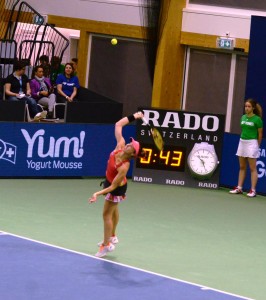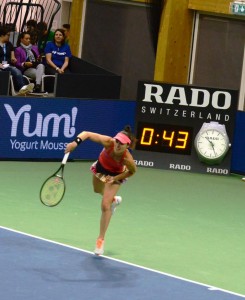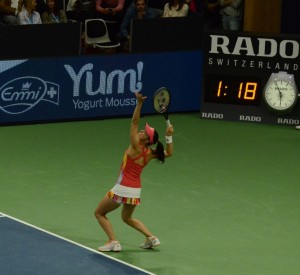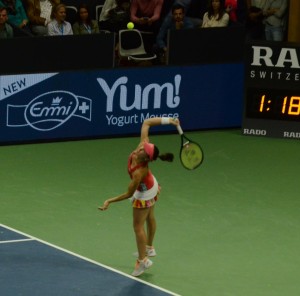Martina Hingis – Service over the course of the time

Czech-Slovak born Martina Hingis (*80 / SUI), former world # 1 in both singles and doubles, was, after two breaks in her career, very successful doubles player until her late 30’s and she retired as the actual doubles #1 in the end of 2017. The as the “Swiss Miss” called Martina was coached through the entire career by her mother Melanie Molitor (CZE / SUI) and was/is known for her very controlled technique as well as for a great feel for the ball and the game. For many years, the service could have been considered as Martina’s biggest weakness, mainly due to a suboptimal form and dynamic of the pronation with the elbow staying rather too low and the racket traveling rather too much on the horizontal plane after the impact. Over the course of the years, Martina was able to improve it a bit and her pronation did look much better later in her career. With the elbow slightly above the shoulder level during the follow through 1, she was later able to fulfill the elementary Service 3.0 requirements quite well. The rather horizontal path of the racket partly remained, but the vertical element has partly increased in most of her 1st services in the later years. The fact, that Martina keeps her hitting arm for quite a long time in the position with the “palm facing to the outside” is quite typical for players, who have learned the full proper pronation rather late in their careers. Such motion is then not quite “hard-wired” in their brains, what mostly takes away some of the fluidity of the motion, as well as some of the full body energy unloading, and such strokes remain partly vulnerable in the critical situations. In her best service at the end of her doubles career, Martina was able to well unload the body energy into the pronation against the target, but she still has had the tendency to lose the optimal form and timing of this action from time to time during her matches. She was then obviously able to offset this particular weakness with her enormous qualities in other areas, mainly in the net game, which has been covered in a post on this website.
Below, I am sharing a selection of images documenting Martina’s service and its development over the course of 18 years. Service 3.0 means that the stroke is being dominated by the body energy (and not be the energy from the activity of the arm). With Martina as with all the very top players, most of the 1st services are obviously of the 3.0 category, but there are still differences there regarding the best efficiency of these Sevices 3.0. In the general, the most efficient ones, which posses also the biggest margin and bring the best service percentages, have a quite strong vertical component (up and down) before and after the impact, which leads to an optimal unloading of the rotational body energy against the target in the form of the long axis pronation and imparts mostly also a bit more of the spin, which is the underlying reason behind the increased margin. The players with a rather horizontal action mostly have rather weaker services and mainly lower margins.

Martin Hingis (*1980 / SUI) – 1st service in the practice – end of follow through 1 – elbow stays rather low, pronation is limited, rather long horizontal motion – limited body energy unloading – 2000 Wimbledon Championships – London / UK – June 2000

Martin Hingis (*1980 / SUI) – 1st service 3.0 in a practice match – follow through 1 – the position of the elbow and the pronation are partly better – the integration of the body energy into the stroke is then also better – still very strong horizontal component – 2001 US.Open – New York / USA – August 2001

Martina Hingis (*1980 / SUI) – 1st service 3.0 in a practice – 1 of 5 – start – calm well-balanced starting position in a platform stance – 2014 US.Open – New York / USA – August 2014

Martina Hingis (*1980 / SUI) – 1st service 3.0 in a practice – 2 of 5 – loading – remaining in a platform stance – 2014 US.Open – New York / USA – August 2014

Martina Hingis (*1980 / SUI) – 1st service 3.0 in a practice – 3 of 5 – push-off/acceleration from the cocking position against the tossed ball – 2014 US.Open – New York / USA – August 2014

Martin Hingis (*1980 / SUI) – 1st service 3.0 in a practice – 4 of 5 – follow through 1 aka targeted pronation – solid body energy unloading against the target – 2014 US.Open – New York / USA – August 2014

Martin Hingis (*1980 / SUI) – 1st service 3.0 in a practice – 5 of 5 – follow through 2 – relaxation with a racket speed deceleration – calm as the majority of the energy was unloaded already – 2014 US.Open – New York / USA – August 2014
Martina Hingis (*1980 / SUI) – 1st service 3.0 in a doubles match – 1 of 1 – follow through 1 – good combination of the elbow elevation and pronation – more of a vertical component leading to a solid body energy unloading against the target – WTA 250 Biel / Switzerland – April 2017

Martina Hingis (*1980 / SUI) – 1 st service 3.0 in a doubles match – 1 of 2 – follow through 1 – targeted pronation – elbow is quite high here, the racket is moving a bit too long to the front, the best servers would mostly have slightly more of the vertical component involved while having the struck ball at the same distance away from them as shown here – WTA 250 Biel / Switzerland – April 2017

Martina Hingis (*1980 / SUI) – 1st service 3.0 in a doubles match – 2 of 2 – follow through 2 – relaxation/deceleration – WTA 250 Biel / Switzerland – April 2017

Martina Hingis (*1980 / SUI) – 1st service 3.0 in a doubles match – 1 of 1 – follow through 1 aka targeted pronation – the vertical component is slightly more dominant here than in the 1st service shown directly above – such small differences play quite in big role in the top of the tennis game – WTA 250 K Biel / Switzerland – April 2017

Martina Hingis (*1980 / SUI) – 1st slice service 3.0 in a doubles match – 1 of 4 – toss – from a calm platform stance – WTA 250 Biel / Switzerland – April 2017

Martina Hingis (*1980 / SUI) – 1st slice service 3.0 in a doubles match – 2 of 4 – push-off/acceleration towards the ball – pushing off the rather wide platform stance might be also a slightly limiting factor regarding vertical action – WTA 250 Biel / Switzerland – April 2017

Martina Hingis (*80 / SUI) – 1st slice service 3.0 in a doubles match – 3 of 4 – follow through 1 = targeted pronation – quite dominant vertical component, the form of the pronation is typical for the slice – WTA 250 Biel / Switzerland – April 2017

Martina Hingis (*1980 / SUI) – 1st slice service 3.0 in a doubles match – 4 of 4 – follow through 2 = relaxation/deceleration – WTA 250 Biel / Switzerland – April 2017

Martina Hingis (*1980 / SUI) – 1st service 3.0 in a doubles match – 1 of 6 – start – wide stable platform stance – WTA 250 Biel / Switzerland – April 2017

Martina Hingis (*1980 / SUI) – 1st service 3.0 in a doubles match – 2 of 6 – toss/take-back – WTA 250 Biel / Switzerland – April 2017

Martina Hingis (*1980 / SUI) – 1st service 3.0 in a doubles match – 3 of 6 – push-off beginning – from the platform stance, racket travel into the cocking position – WTA 250 Biel / Switzerland – April 2017

Martina Hingis (*1980 / SUI) – 1st service 3.0 in a doubles match – 4 of 6 – acceleration from the cocking position towards the impact – excellent high elbow position, good eye control – WTA 250 Biel / Switzerland – April 2017

Martina Hingis (*1980 / SUI) – 1st service 3.0 in a doubles match – 5 of 6 – follow through 1 aka targeted pronation – good rotational body energy unloading – WTA 250 Biel / Switzerland – April 2017

Martina Hingis (*1980 / SUI) – 1st service 3.0 in a doubles match – 6 of 6 – follow through 2 = deceleration/relaxation – WTA 250 Biel / Switzerland – April 2017
This article covers certain aspects of Martina Hingis’ service and service in general only. Further photos, more details about her service (including improvement possibilities) and other strokes as well as about the strokes of other players are available upon request at drmgb11(at)gmail.com. Some significant details of this kind, necessary for a top tennis performance as well as for a sustainable tennis training/development in general, are being discussed also in the seminar “TENNIS 3.0 – Future of the Game”, which is available worldwide upon request – www.tennis30.com / www.tennis30.cz
Photos (June 2000 & August 2001 & August 2014 & April 2017) & text (May 2017 – February 2018) copyright by Dr. Martin G. Baroch. Any further publication of either any of the photos & and/or texts with the explicit written permission issued by the author/copyright owner only!!




